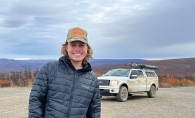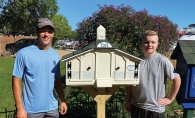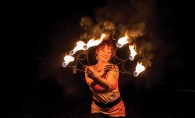Ask a 10- or 11-year-old to recap their summer, and you might expect to hear about a trip to the beach or maybe a favorite summer book. Ask Maria and Miller Williams, and they’ll mention paleontology camp or the Midwest Museum Convention. And they’ll say it like it’s no big deal.
Maria, 11, is in sixth grade at Orono Middle School. Her brother Miller is 10 and in fourth grade at Orono Intermediate School. The siblings have a passion for natural history—and they’re running with it. At their Minnetrista home, they even moved into a shared bedroom to make space for their bona fide museum, the Tiny Natural History Museum, complete with admission fee and a gift shop. Now, they’re starting to share their knowledge with kids (and grown-ups) all over the Twin Cities.
“We like bugs and plants and stuff like that,” says Maria. She and Miller have had an interest in natural history since they were very young, and their parents and teachers have encouraged their exploration. Their permanent museum collection includes rocks and fossils, seashells, a cow pelvis, a mountain lion skull, an armadillo shell, and coprolite (which is, ahem, fossilized poop). The museum has gotten a little more sophisticated over the last year, as they’ve officially opened it to family and friends to visit. They’ve also done traveling public exhibitions and several media appearances.
So what does it take to make it into the Williamses’ 300-plus-item museum? “The first thing we do is decide the category it should fall into—fossils, rocks, animal remains—and then label it and put it in the museum,” says Maria, who got a label maker for her birthday last summer. The same month, she attended Be a Paleontologist camp at the Science Museum of Minnesota, honing her fossil-excavation and dinosaur-identification skills.
Miller opted for hockey camp and soccer this year but says he’s been very interested in dinosaurs since he was 2. “Sea creatures—sharks, jaws, and teeth—lots of cool things. Lots of old stuff.” His favorite item in the museum to date is an alligator skull, passed down from his Great-Grandpa Lars. “It’s as wide as your whole hand!” Miller says.
He recalls Maria once telling their parents, “When you see dinosaurs walking the earth, you’ll know it was me who did that!” (Yes, they’ve seen Jurassic Park, and they also recommend their favorite science podcast, Brains On!)
Jennifer Menken is on the exhibits team and manages public collections at the Bell Museum of Natural History at the University of Minnesota. (If there were a huge version of Maria and Miller’s hands-on museum, the Bell would be it.) Menken has gotten to know the Williams siblings and helped award them the title of Bell Museum Tiny Curator for their involvement with the museum over the past year.
“Our goal at the Bell Museum is ‘to ignite curiosity and wonder,’ but I think we can encourage it, too. I think we can all go back to a point in our childhood where someone left an impression and inspired us to do what we do today,” says Menken. “If you catch ’em young, they’re hooked.”
Menken’s colleague, Andria Waclawski, first learned about the Williams kids while they were showing a mini-exhibit at Southshore Center. “She said, ‘These kids are awesome,’ ” says Menken. Pretty soon the Williamses had scored a personal tour of the Bell Museum—including some collections that aren’t open to the public.
They’ve since been guest scientists at the Bell’s monthly Saturday with a Scientist event, sharing with other kids how to create a rock collection in an egg carton. The encouragement—and fascination with all things natural history—goes both ways. “They’re really excited for us, too, which is cool,” says Menken. When the Williamses held their first public exhibition in January at the Southshore Center, they charged a $2 admission fee and planned to donate half the proceeds to the Bell Museum. When over 75 people showed up, the young paleontologist-philanthropists were true to their word and donated a chock-full Ziploc bag of small bills and change to the museum.
They also keep the Tiny Natural History Museum active on social media. Mom Anna acts as media agent and does the social media posts for them. “We don’t really go on social media without Mom,” explains Maria. “We do the work, and she posts and tells us not to click on the pop-up ads.” The kids have been featured in the Lakeshore Weekly News, the Laker & Pioneer, on a KARE-11 Land of 10,000 Stories feature, and this fall will be included in a Scholastic science magazine that’s mailed to schools nationwide.
As for long-term plans, Maria says the museum idea has been in the works for a while. “I did kind of want to have an operational museum—but I didn’t expect the media attention,” says Maria. “I would like this to get bigger and be a legitimate museum.” Someday she wants to be a paleontologist, and she’d like to study the Mesozoic era (that’s 252 million to 66 million years ago, in case you were wondering). Miller? He’ll follow in his sister’s footsteps, but he’d like to get a little more specific and focus on all things Jurassic. (That’s 201 million to 145 million years ago, the middle chunk of the Mesozoic era.) Miller says if he’s not a paleontologist, he’ll play hockey in the NHL.
“When Miller gave up his bedroom to have space, we thought it would be a passing interest,” says Anna, who’s had a front-row seat to the growing interest in her kids’ hobby. “But it stuck. It has not been what we expected. But it’s been really fun to watch them grow and learn.”
“Everybody thinks we push the kids—but they’re natural-born collectors. Whether they collect sparkly rocks or bugs or PEZ dispensers,” says Menken. “But we always hope kids take that next step: collect, curate, teach. What most intrigued us about these kids is that they already have. The fact that a brother and a sister decided to share their bedroom to make room for a history museum—it’s exciting!” says Menken.
Check out the Tiny Natural History Museum on Facebook for more info about exhibits and events.









